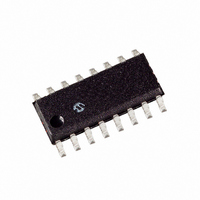MCP3008-I/SL Microchip Technology, MCP3008-I/SL Datasheet - Page 17

MCP3008-I/SL
Manufacturer Part Number
MCP3008-I/SL
Description
IC ADC 10BIT 2.7V 8CH SPI 16SOIC
Manufacturer
Microchip Technology
Specifications of MCP3008-I/SL
Number Of Converters
1
Package / Case
16-SOIC (0.154", 3.90mm Width)
Number Of Bits
10
Sampling Rate (per Second)
200k
Data Interface
Serial, SPI™
Voltage Supply Source
Single Supply
Operating Temperature
-40°C ~ 85°C
Mounting Type
Surface Mount
Architecture
SAR
Conversion Rate
200 KSPs
Resolution
10 bit
Input Type
Voltage
Snr
200 dB
Maximum Operating Temperature
+ 85 C
Mounting Style
SMD/SMT
Minimum Operating Temperature
- 40 C
Package
16SOIC N
Sampling Rate
200 KSPS
Number Of Adcs
1
Number Of Analog Inputs
8|4
Digital Interface Type
Serial (4-Wire, SPI)
Polarity Of Input Voltage
Unipolar
Lead Free Status / RoHS Status
Lead free / RoHS Compliant
Lead Free Status / RoHS Status
Lead free / RoHS Compliant, Lead free / RoHS Compliant
Available stocks
Company
Part Number
Manufacturer
Quantity
Price
Company:
Part Number:
MCP3008-I/SL
Manufacturer:
MICROCHIP
Quantity:
2 100
Part Number:
MCP3008-I/SL
Manufacturer:
MICROCHI
Quantity:
20 000
6.0
6.1
With most microcontroller SPI ports, it is required to
send groups of eight bits. It is also required that the
microcontroller SPI port be configured to clock out data
on the falling edge of clock and latch data in on the ris-
ing edge. Because communication with the MCP3004/
3008 devices may not need multiples of eight clocks, it
will be necessary to provide more clocks than are
required. This is usually done by sending ‘leading
zeros’ before the start bit. As an example, Figure 6-1
and Figure 6-2 shows how the MCP3004/3008 can be
interfaced to a MCU with a hardware SPI port.
Figure 6-1 depicts the operation shown in SPI Mode
0,0, which requires that the SCLK from the MCU idles
in the ‘low’ state, while Figure 6-2 shows the similar
case of SPI Mode 1,1, where the clock idles in the ‘high’
state.
As is shown in Figure 6-1, the first byte transmitted to
the A/D converter contains seven leading zeros before
the start bit. Arranging the leading zeros this way
induces the 10 data bits to fall in positions easily manip-
ulated by the MCU. The MSB is clocked out of the A/D
converter on the falling edge of clock number 14. Once
the second eight clocks have been sent to the device,
the MCU receive buffer will contain five unknown bits
(the output is at high impedance for the first two
clocks), the null bit and the highest order 2 bits of the
conversion. Once the third byte has been sent to the
device, the receive register will contain the lowest order
eight bits of the conversion results. Employing this
method ensures simpler manipulation of the converted
data.
Figure 6-2 shows the same thing in SPI Mode 1,1,
which requires that the clock idles in the high state. As
with mode 0,0, the A/D converter outputs data on the
falling edge of the clock and the MCU latches data from
the A/D converter in on the rising edge of the clock.
2002 Microchip Technology Inc.
APPLICATIONS INFORMATION
Using the MCP3004/3008 with
Microcontroller (MCU) SPI Ports
MCP3004/3008
DS21295B-page 17














